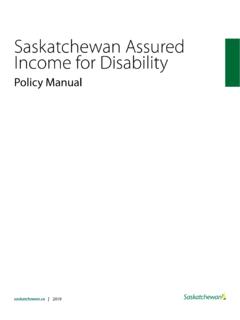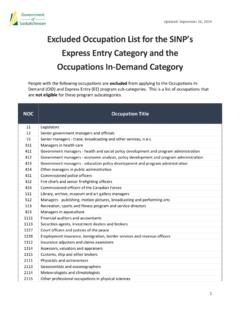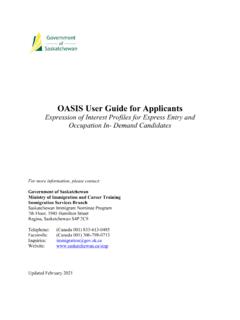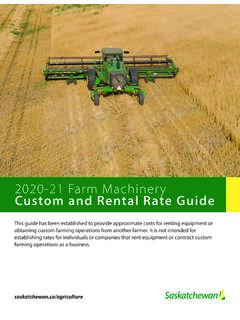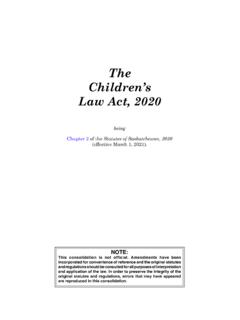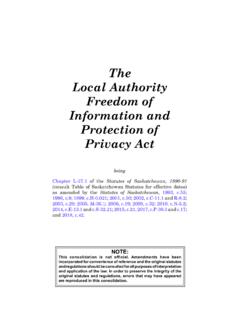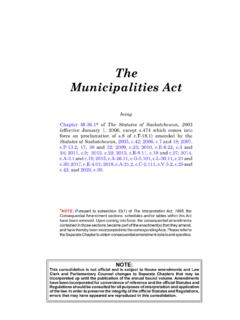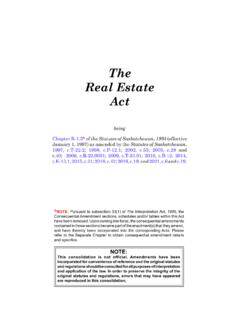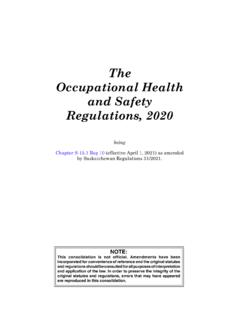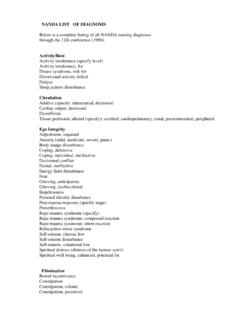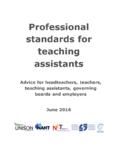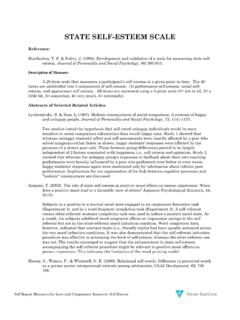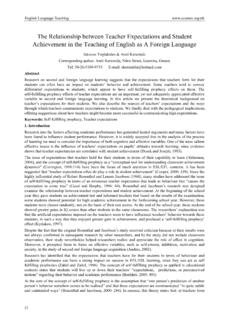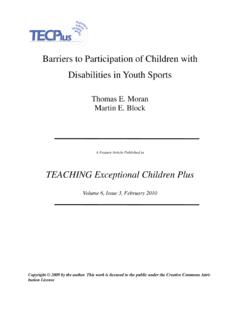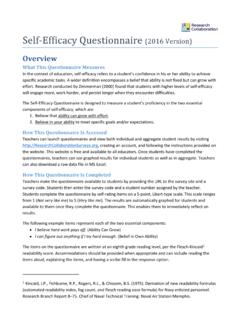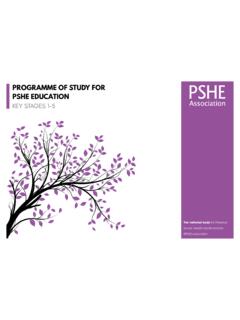Transcription of Teaching Students with Visual Impairments
1 Teaching StudentswithVisual ImpairmentsWeb site: Carney, Saskatoon Public School DivisionConnie Engbretson, Rosetown School DivisionKaren Scammell, Tisdale School DivisionValarie Sheppard, Outlook School DivisionAdvisory and EditorialGarnett Francis, Saskatchewan LearningGail Clark, Saskatchewan LearningFor further information contact:Saskatchewan LearningSpecial Education Unit2220 College AvenueRegina, SaskatchewanS4P 3V7 Telephone: (306) 787-1183 Facsimile: (306) 787-0277 Copyright 2003 Permission is given by the copyright owner to reproduce this document foreducational purposes and on a non-profit of ContentsIntroduction .. 1 Notes for Administrators .. 2 Section INature of Visual impairment .. 3 Needs and Expectations of Students with Visual Impairments .. 6 Educational Implications of Visual impairment .. 6 Section IIAssessment .. 9 Section IIIThe Support Team.
2 11 Section IVThe Student with Low Vision .. 17 Section VThe Student with Blindness .. 31 Section VIThe Student with Visual impairment and Other Disabilities .. 43 Section VIIS pecialized Materials, Equipment and Technology .. 47 Section VIIIO rientation and Mobility .. 55 Section IXTransition Planning .. 59 Section XAppendices .. 63 Section XIGlossary .. 105 Section XIIT eaching Resources .. 113 Resources for Teaching Braille .. 115 Section XIIIC ontact InformationPublishers .. 117 Specialized Materials, Equipment & Technology .. 120 Section XIVC ommunity Resources in Saskatchewan .. 121 Section XVInternet Resources .. 123 Section XVIR eferences .. 1251 IntroductionThis resource offers basic information to help provide successful schoolexperiences for Students who are blind or visually guidebook will include information regarding: the nature of the student s Visual impairment ; the specific needs of Students with Visual Impairments ; the specific needs of Students with Visual Impairments and other disabilities; assessment; instructional strategies; the use of technology; the importance of orientation and mobility instruction; transition planning; terminology used in referring to Visual Impairments (see Glossary); and recommended for AdministratorsThe attitude of the in-school administrator toward the inclusion of a student with avisual impairment is one of the main factors affecting the success or failure ofattempts to provide inclusive education.
3 The administrator s attitude influences theattitudes of others, therefore creating a climate of acceptance or of administrator who believes in the inclusion of a student with a Visual impairmentwill: make a commitment to the student that is reflected in the actions of theadministrator; work to educate others to assist them in overcoming fear and prejudices. This willinvolve the provision of resources, both print and human, to teach about visualimpairment and to encourage inservice for staff and Students . Opportunities foropen communication and networking with others who have experienced teachingstudents with Visual Impairments is important; involve teachers in the planning. Teachers need to be informed and to feel thatthey have opportunities to prepare and learn about the student s needs; address concerns and needs of teachers. Provide opportunities for teachers tocommunicate with each other.
4 Provide resource materials, problem solvingsessions and networking time; work to find the time and the resources necessary to support teachers in theclassroom; establish a school-based support team and encourage collaboration, consultationand cooperation. Be an active member of this team. Provide the necessaryrelease time so that collaboration may occur; encourage staff members to attend inservice sessions and to network with otherteachers ( , ACCESS Workshops, Insight Conference); establish partnerships with parents and increase opportunities for parentinvolvement; assign a teacher assistant based upon student need. A student with a visualimpairment does not always require this support. The role of the teacher assistantmust be defined; facilitate the consultation with the ACCESS (Assistance, Collaboration,Consultation, Evaluation Support Services Saskatchewan Learning) consultation will provide recommendations and feedback that is importantinformation for an administrator; support other consultations which may be required for the student ( ,Orientation and Mobility Instruction, Technology Assessment); and understand the needs of the student to provide support for the program.
5 Theunique curriculum needs will require considerations such as the student travelingto a larger community for travel skills, cooking and other life I Nature of Visual ImpairmentVisual impairment refers to a significant loss of vision, even though the person maywear corrective lenses. The nature and degree of Visual impairment may varysignificantly, so each student may require individual adaptations to instructionalpractices and materials in order to learn impairment includes two main categories: blindness and low Blindness ranges from a Visual acuity of 20/200 in the better eye aftercorrection, to having no usable vision or a field of vision reduced to an angle of 20degrees. Visual acuity of 20/200 means that the individual sees at 20 feet what isnormally seen at 200 feet. A reduced field of vision means that the individual hastunnel vision with limited peripheral ranges from being totally without sight to unreliable vision and primaryreliance on other senses.
6 A person with blindness usually uses braille as a readingand writing Vision is reduced central acuity of 20/70 or less in the better eye Students with Visual Impairments have low vision. These Students should beencouraged to use their residual (remaining) vision, when appropriate, using thenecessary optical aids and adaptations. Students who are described as blind mayhave some usable Impairments are further classified as congenital or refers to loss of vision present at birth. Some of the more commoncauses of congenital Visual impairment are: prematurity; genetic diseases; prenatal and perinatal infections; and maternal substance refers to loss of vision acquired after birth as a result of illness age and level of development of the student before the onset of the visualimpairment influences the student s ability to acquire skills and concepts.
7 Studentswith congenital blindness may have difficulty acquiring concepts, while Students withadventitious blindness may retain sufficient Visual memory to benefit from two Students may be medically assessed as having the same diagnosis andvisual acuity, they may each learn and function in different ways. A student s visionmay fluctuate or may be temporarily influenced by such factors as: the nature of the Visual impairment ; fatigue; glare; inappropriate lighting; medication; and general Eye ConditionsFollowing are the most common eye conditions teachers may : Albinism is a genetic condition in which there is a lack of normal pigment inthe eyes and often in the skin and hair. Students with albinism usually have reducedvisual acuity, sensitivity to light and nystagmus (see below definition).Amblyopia: Amblyopia is referred to as a lazy eye.
8 There is reduced visualfunctioning in one eye that causes the student to use only one eye instead of : A cataract is an opacity or cloudiness of the lens of the eyes, sometimespresent at birth. Students with cataracts have reduced Visual acuity and hazy visionthat makes near and distant Visual activities difficult, particularly in bright light. Theymay have poor colour Visual impairment : Cortical Visual impairment is caused by damage to thevisual cortex in the brain or the nerve pathways. Most Students with cortical visualimpairment also have other disabilities. The Visual response from Students withcortical Visual impairment is inconsistent. Providing Visual stimulation may improvethe student s ability to process Visual detachment: A retinal detachment occurs when parts of the retina pull awayfrom the supporting structure of the eye and atrophy occurs. The retina may bereattached if little time has : Glaucoma is a disease in which there is damage to the optic nerve,through increased pressure from the fluid within the eye, resulting in reduced visualacuity and loss of peripheral vision.
9 The fluid pressure is monitored regularly by anophthalmologist. Students with glaucoma generally have difficulty with mobility andfocusing their gaze between near and distant : Hyperopia (farsightedness) is a condition in which the rays of lightentering the eye focus behind the retina instead of on the retina. Students withhyperopia can see more clearly at a degeneration: Macular degeneration is an eye disease which results ingradual loss of central vision. Students with macular degeneration have difficultyreading print on the blackboard or : Myopia (near sightedness) is a condition in which the rays of light enteringthe eye focus in front of the retina instead of on the retina. Students with myopia cansee more clearly up : Nystagmus is involuntary movement of the eyes that can cause fatiguewhen carrying out Visual tasks. Nystagmus is associated with many eye conditions orit may be the only diagnosis identified by an atrophy: Optic atrophy is the degeneration of the optic nerve fibers so thatthey are no longer able to transmit accurate Visual images from the retina to the ophthalmologist will sometimes describe a student as having pale or grey opticdisks in one or both eyes, which is an indication of optic atrophy.
10 It is important todetermine just how well the student can interpret what is seen both up close and at pigmentosa: Retinitis pigmentosa is a hereditary condition in which theretinal cells degenerate, particularly the rods which are responsible for peripheral andnight vision. This results in a progressive narrowing of the field of vision, nightblindness and often extreme sensitivity to light. Students with retinitis pigmentosahave difficulty with mobility, scanning the environment and reading print on theblackboard or of prematurity: Retinopathy of prematurity is a disease of the retina inwhich the retinal blood vessels do not develop normally and scar tissue forms. Moststudents with retinopathy of prematurity benefit from the use of high illumination andmagnifying : Strabismus is a muscle imbalance that prevents the eyes from focusingtogether on a single point to achieve binocular vision.
